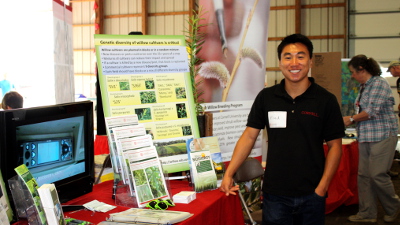Navigate This Page:
Cornell Bioenergy

The CALS Bioenergy Feedstock Project conducts research on the management and production of perennial grasses in New York, as well as extensive work with the Cornell Cooperative Extension to disseminate information on bioenergy. Visit their website below:
In collaboration with VVS High School faculty, Cornell Cooperative Extension of Oneida County, and SUNY-ESF a demonstation field trial of shrub willow, sorghum, and switchgrass has been established and will be used for educating students in the VVS High School Ag program and provide biomass for production of heat and electricity for the school. Learn more about Cornell’s outreach and extension mission below:
Shrub Willow Biomass Producer’s Handbook
The Shrub Willow Biomass Producer’s Handbook describes the benefits of growing willow as a bioenergy crop and explains the process of the willow biomass production system, which is based on a combination of agricultural and forestry practices.
The goal is to aid farmers in achieving the best returns in yield and profit.
Currently in New York State alone there is approximately 1.5 million acres of barren or underutilized farm land. Exploiting this resource could improve the farm finances, as well as stimulate the rural economy, by providing a new source of revenue, a new crop market, and environmental benefits.
This handbook has been produced by the State University of New York College of Environmental Science and Forestry (SUNY-ESF) to introduce farmers in upstate New York the Northeast, and the Lake States to shrub willow and offer guidelines on how to manage this new crop.
To view and download the handbook, please visit: https://www.esf.edu/willow/documents/ProducersHandbook.pdf.
Fact Sheets
The fact sheets below contain information on willow breeding, pests, and diseases. Fact sheets relating to cultivar releases are organized by genetic diversity group.
Shrub Willow Breeding
- Breeding & Commercialization of Shrub Willow Bioenergy Crops
- Zone Tillage & GPS-Guided Planting
- Improving the Yield of Shrub Willow Bionergy Crops
- Demonstrating Yield of Shrub Willow Bioenergy Crops Big Flats Field Day
Shrub Willow Pests
- Willow Leaf Beetle Plagiodera versicolora
- Willow Sawfly Nematus ventralis
- Potato leafhopper Empoasca fabae
- Japanese Beetle Popillia japonica
Shrub Willow Diseases
- Leaf Rust Melampsora spp.
- Willow Scab Venturia saliciperda
- Botryosphaeria B. dothidea and B. ribis
- Leucostoma Canker Leucostoma niveum
- Black Canker Glomerella miyabeana
- Powdery Mildew Erysiphe adunca and Phyllactinia guttata
Shrub Willow Cultivar Releases
Commercial Cultivars Represent 9 Diversity Groups:
Diversity Group 1
Diversity Group 3
Diversity Group 4
Diversity Group 5
- ‘SX61’ Salix miyabeana – Under revision
- ‘SX64’ Salix miyabeana
- ‘SX67’ Salix miyabeana
- ‘Canastota‘ S. miyabeana – Under revision
- ‘Sherburne‘ S. miyabeana – Under revision
Diversity Group 6A
Diversity Group 6B
Diversity Group 8
- ‘Tully Champion‘ Salix viminalis × S. miyabeana
- ‘Owasco‘ Salix viminalis × S. miyabeana
- ‘Otisco‘ Salix viminalis × S. miyabeana
- ‘Preble’ Salix viminalis x S. miyabeana
- ‘Fabius’ Salix viminalis x S. miyabeana
Diversity Group 9
For more information about willow diversity, see Genetic Diversity of Willow
Fact sheets from other institutions
- Information on woody biomass from the Michigan State University (MSU) Wood Energy Team. Also see several articles and documents authored by MSU’s Bill Cook on the topic of wood energy.
- An economic model of shrub willow biomass production from SUNY-ESF